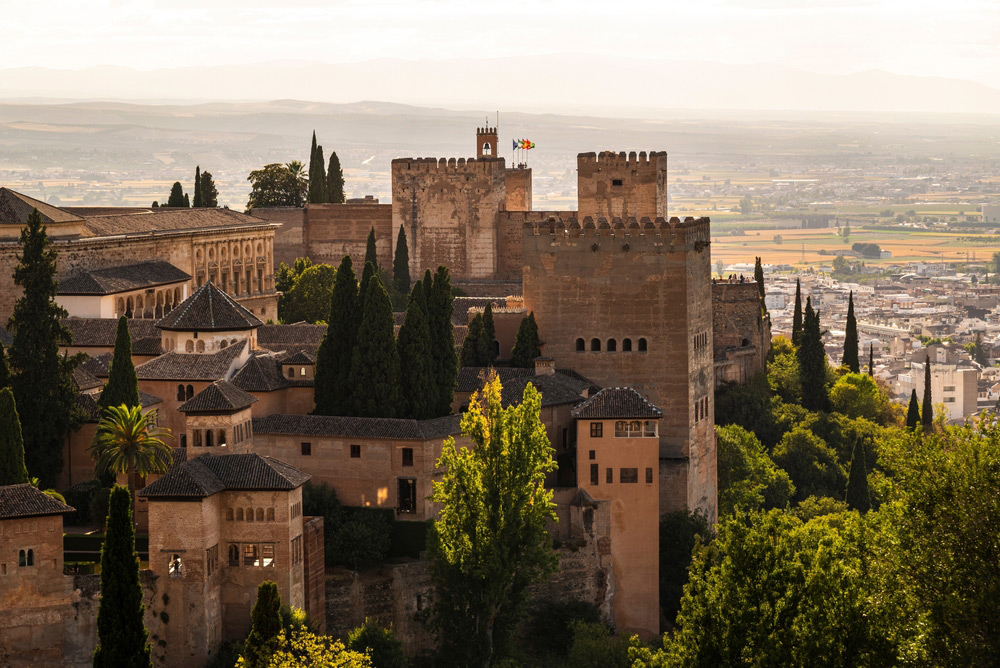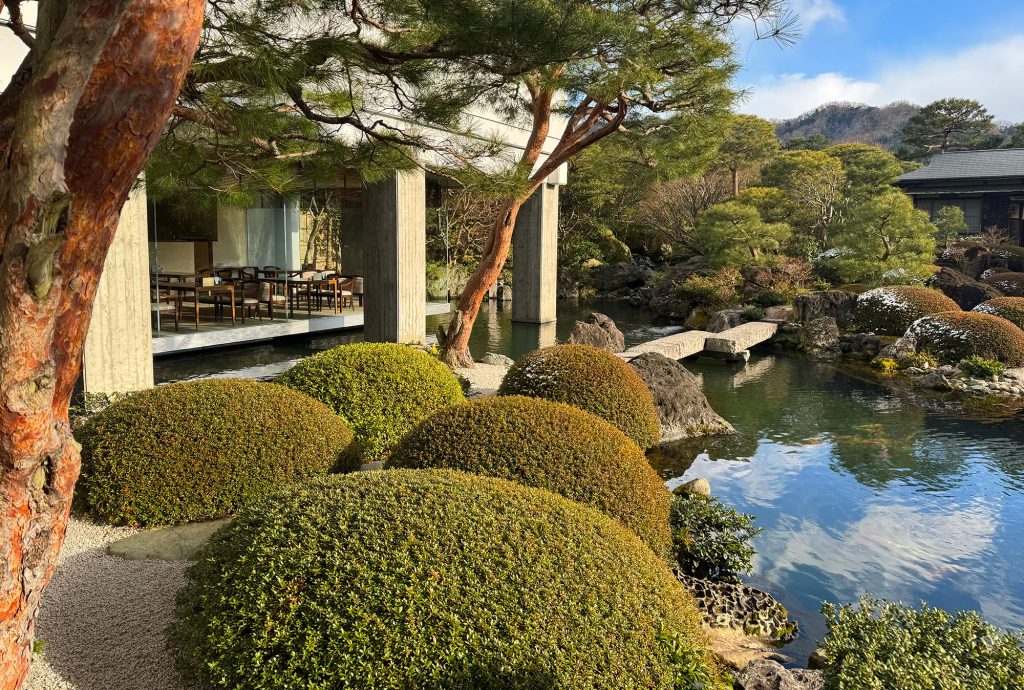Introduction: Historical Significance
La Alhambra, perched on the rolling hills of Granada, is more than just a palace; it’s a testament to centuries of culture and confluence.
This magnificent fortress complex, established in the mid-13th century by the Nasrid emirs, represents Spain’s pinnacle of Moorish civilization.
It served as both a royal court and a defense mechanism, embodying its rulers’ opulence and strategic prowess. Over time, it became a symbol of the rich tapestry of Islamic and Western influences.


UNESCO World Heritage Site
Recognized as a UNESCO World Heritage Site, La Alhambra is celebrated for its architectural brilliance and historical importance.
This designation helps preserve not only the intricate architecture but also the cultural narratives etched into its walls, ensuring that future generations can marvel at its splendor.
The Moorish Architecture of La Alhambra
Moorish architecture, a unique blend of Islamic art, traditional Arabian styles, and local Spanish elements, finds its highest expression in La Alhambra. Key features include horseshoe arches, ornate tilework, and expansive courtyards designed to offer tranquility.

The use of light and shadow, along with water elements, creates an immersive experience, reflecting the seamless blend of nature and crafted beauty.
The Alhambra stands as a testament to the splendor of Moorish architecture, embodying a unique blend of elegance and functionality.
Its design merges intricate artistry with strategic construction, creating spaces that are both aesthetically pleasing and utilitarian.
Key features include horseshoe arches, vaulted hallways, and arabesque motifs. These elements showcase the Moorish commitment to beauty and balance in every corner of this magnificent fortress palace.

Geometric patterns and intricate tilework are hallmarks of the Alhambra. The use of tessellations, repeating geometric shapes, and sophisticated mosaics, reflects the Moorish emphasis on harmony and symmetry.
This art form provides both decorative beauty and structural balance. The tiles, often in bright blues, greens, and golds, create spaces that shimmer with color and light.
The journey into La Alhambra reveals a world where architecture and artistry merge, setting the stage for deeper exploration into its intricate wonders.
The Court of the Lions: An Architectural Marvel
The Court of the Lions is the heartbeat of La Alhambra, a remarkable display of Moorish design ingenuity. It’s not just a courtyard; it’s a masterpiece where water, nature, and architecture harmoniously coexist.

The 12 marble lions forming the fountain are expressive symbols, each one meticulously carved to represent strength and vigilance.
The Court of The Lions serves as a vivid representation of political and cultural messages. It was in these serene surroundings that the Nasrid rulers showcased their power and sophistication.
The blend of different artistic traditions within the court embodies Alhambra’s story—a confluence of cultures, where East meets West in a harmonious embrace.

Surrounding this fountain are 124 slender marble columns, creating a rhythmic symmetry that adds to the court’s allure.

The Iconic Fountain
The fountain itself is an engineering wonder. Designed to evoke harmony and tranquility, the gentle flow of water reflects the Islamic emphasis on paradise gardens.
Its very structure commemorates the balance of the universe, with each lion facing a cardinal direction, symbolizing time and the passing of days.
This detailed craftsmanship reflects both artistic achievement and the cultural interchange between Islamic and Christian traditions.
As we explore further into La Alhambra, each element unfolds a new narrative, deepening our appreciation of this historic marvel.
The Hall of the Ambassadors: Grandeur and Political Importance
The Hall of the Ambassadors stands as a breathtaking testament to the political power and artistic achievement of the Nasrid dynasty.
This magnificent room was the site of grand diplomatic meetings and solemn ceremonies. Its sheer size, with a ceiling soaring to 75 feet, reflects the majesty and authority once wielded within its walls.

Architectural Features and Decorative Elements
Adorned with intricate geometric and arabesque patterns, the Hall dazzles with its aesthetic beauty.
The walls are richly covered in ornate stucco work and colorful tiles, illustrating the zenith of Moorish craftsmanship.
The gilded wooden ceiling, meticulously crafted, combines interlocking stars and mosaics, embodying celestial harmony. These elements together create an ambiance of both grandeur and intimacy.
Historical Significance
Throughout history, the Hall of the Ambassadors has been a focal point for significant events, including the reception of Christopher Columbus by King Ferdinand and Queen Isabella, a meeting that foreshadowed the dawn of an age of exploration.
Embodying elegance through its art and architecture, the Hall of the Ambassadors provides a captivating link between past power and present awe.
As you explore its graceful intricacies, one can’t help but feel the whispers of ancient conversations, setting the stage for yet another enchanting journey through La Alhambra.
Poetry on the Walls: Intricate Calligraphy and Inscriptions
As you stroll through the Alhambra, the walls whisper tales of the past with elegant Arabic script delicately etched across them.

This calligraphy is not merely decorative; it serves as a vital element of Islamic art, enriching the palace with its intricate beauty. These inscriptions often include poetic verses, reflecting themes of paradise, power, and piety.
Meaning and Significance of the Poetic Verses
The poetry adorning the walls is rich with meaning, often celebrating the achievements of the Nasrid dynasty or invoking divine wisdom.
Each verse is meticulously chosen to resonate with the surroundings, creating a dialogue between the written word and architectural form.
The balance between poetry and structure exemplifies the Islamic belief in the unity of all forms of art and expression.
The Generalife Gardens
The Generalife Gardens, a serene escape near the Alhambra, exemplify Moorish brilliance in landscape design. These gardens serve as a summer palace, a peaceful retreat for the Nasrid sultans.

The layout is a series of terraces, each offering a unique perspective and a lush array of plant life. Pathways wind through meticulously designed spaces, connecting the architectural and natural elements seamlessly.
Significance of Water Features
Water is the lifeblood of the Generalife. Fountains and pools are central, creating a tranquil atmosphere with their gentle sound and reflective surfaces.
The use of water not only cools the environment but also represents purity and life, essential principles in Islamic culture. The clever irrigation system showcases the ingenuity and foresight of Moorish engineers.

Connection Between Nature and Architecture
The interplay of light and shadow, combined with the fragrance of flowers and the sound of water, enhances the sensory experience, reflecting the paradise gardens described in Arabic poetry.
Bound by nature’s beauty and innovative architecture, the Generalife Gardens offer a glimpse into the sophisticated world of Moorish art and design.
This embodiment of elegance paves the way to appreciate the intricate aspects of water engineering within the Alhambra complex.
Engineering Marvels
The Alhambra’s water system stands as a testament to Moorish engineering skill. Aqueducts from the nearby Darro River deliver fresh water to the palace.
These aqueducts feed an elaborate network of pools, spouts, and fountains throughout the complex. The precision of the system ensures a constant flow, showcasing the innovative spirit of its creators.

The relationship between architecture and water in the Alhambra continues to amaze visitors, inviting them to ponder the ingenuity behind such harmonious design.
Conclusion
To fully appreciate La Alhambra’s wonders, visitors should take guided tours that highlight the architectural details. Morning visits offer the best light to see the tilework sparkle.
The architectural innovations of the Alhambra have had a lasting impact, influencing styles far beyond the Islamic world.
European Renaissance architects drew inspiration from its arches and courtyard layouts. This influence can still be seen in modern designs, where functionality meets elegance, celebrating the Moorish legacy in contemporary architecture.












